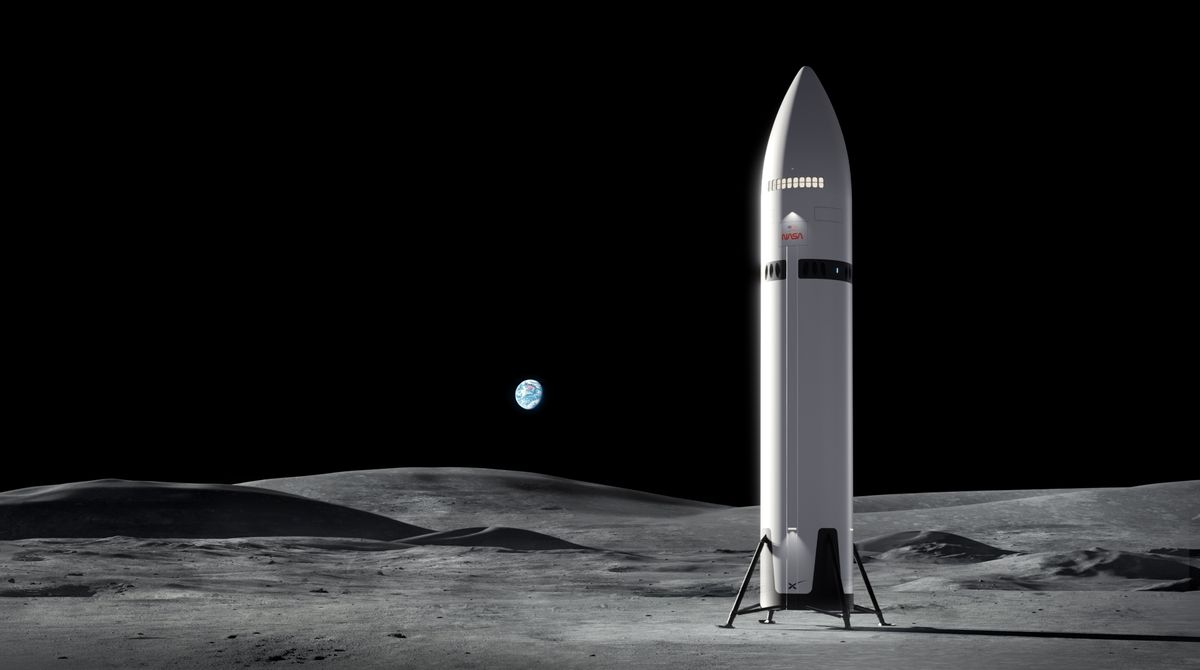SpaceX and NASA have unveiled captivating new artwork illustrating how the innovative Starship rocket could transport astronauts for NASA’s Artemis program to the surface of the moon.
The detailed renders depict a variety of intricate maneuvers and essential steps that SpaceX’s reusable Starship vehicle must execute as part of the ambitious plans for NASA’s Artemis 3 mission, which has been earmarked for no earlier than 2026.
As part of the current mission architecture, a specialized version of Starship known as the Human Landing System (HLS) will rendezvous in lunar orbit with NASA’s Orion spacecraft. During this crucial phase, Artemis astronauts will transition from the Orion capsule into the SpaceX vehicle, which will then ferry them down, ultimately marking the first time human boots will touch the lunar surface since the historic Apollo program concluded in 1972.
In one stunning image, a sleek, white iteration of Starship’s Human Landing System (HLS) is showcased docking nose-to-nose with the Orion spacecraft in the low-gravity environment surrounding the moon. It is during this significant moment that NASA’s Artemis 3 astronauts will transfer from Orion into the HLS, preparing for their lunar descent.
An artist’s concept depicts SpaceX’s Starship Human Landing System (HLS) expertly docking with NASA’s Orion spacecraft as part of its journey to the moon. (Image credit: SpaceX)
Another captivating render illustrates two Starships, one in standard configuration and the other as an HLS variant, performing a critical belly-to-belly docking maneuver to facilitate the transfer of fuel. Since the HLS will carry substantial equipment destined for the moon, it will consume significant amounts of fuel attempting to escape the Earth’s gravitational pull. To effectively manage this, SpaceX is engineering a sophisticated orbital propellant transfer technique, which was partially demonstrated during Starship’s third integrated flight test.
Images showcase that the HLS variant of Starship features a distinct configuration from that of the standard model. Notably, the HLS variant includes windows for crew visibility and lacks the stabilizing fins typically associated with standard Starship designs.
The HLS illustrated in these artistic representations also boasts a striking white exterior, distinguishing it from the polished stainless steel appearance with black thermal protection tiles commonly seen on other Starship configurations.
An artist’s concept displays SpaceX’s Starship Human Landing System (HLS) in action as it embarks on its journey toward the moon. (Image credit: SpaceX)
One render captures two astronauts clad in Axiom Space moon suits as they prepare to descend to the lunar surface using an elevator mechanism.
Test participants, including Axiom Space’s Peggy Whitson and NASA’s Doug Wheelock, successfully validated this capability in June 2024. During that month, they wore Axiom’s suits and engaged in practical evaluations using a mockup of the HLS at SpaceX’s headquarters in California. These tests established that the planned HLS airlock, deck, and elevator can comfortably accommodate astronauts in Axiom’s suits, ensuring the integrity of their mission.
A rendering portrays astronauts making their way to the lunar surface via an elevator after exiting a Starship HLS. (Image credit: SpaceX)
Another eye-catching illustration showcases SpaceX’s Starship HLS as it ignites two of its six Raptor engines in a critical braking maneuver in preparation for lunar landing trials.
An artist’s concept illustrates SpaceX’s Starship Human Landing System (HLS) executing a precise braking maneuver on its mission to the moon. (Image credit: SpaceX)
NASA has officially postponed the Artemis 3 mission until September 2026, deviating from its initial target of launching in 2024. This setback has resulted from a variety of hardware development challenges, including complications related to Orion’s heat shield and extended timelines that SpaceX has encountered in readying Starship for orbital flight.
SpaceX’s projected timelines for Starship have previously demonstrated a tendency toward being overly optimistic. The company’s president and chief operating officer, Gwynne Shotwell, stated in 2019 that the company would accomplish cargo landings on Mars with Starship “in five years.”
Five years later, in 2024, Starship has yet to complete its inaugural orbital flight, although the company has achieved significant advancements through each of the rocket’s six test flights.
**1. How do you foresee the role of SpaceX’s Starship evolving in future lunar missions beyond Artemis 3?**
**Interview with Dr. Emily Carter, Space Exploration Expert**
**Editor:** Thank you for joining us today, Dr. Carter! Exciting developments are happening with SpaceX and NASA’s Artemis program. Can you share your thoughts on the newly unveiled artwork that illustrates the role of the Starship rocket in transporting astronauts to the lunar surface?
**Dr. Carter:** Absolutely, it’s a thrilling time for space exploration! The artwork not only captures the imagination but also highlights the innovative engineering behind the Human Landing System (HLS), a specialized version of SpaceX’s Starship. This system is integral to Artemis 3, which aims to return humans to the moon as early as 2026, marking a monumental moment since the Apollo program.
**Editor:** The renders showcase intricate maneuvers, including the significant moment when the HLS will dock with NASA’s Orion spacecraft. How critical is this phase in the overall mission architecture?
**Dr. Carter:** It’s crucial. The docking phase represents a key transition point where astronauts move from the Orion capsule into the HLS. This interaction will take place in lunar orbit, ensuring a safe transfer before the final descent to the lunar surface. It’s a complex ballet of engineering and human coordination that is vital for mission success.
**Editor:** Another fascinating aspect is the depiction of fuel transfer between Starship variants. What challenges does this present, and how is SpaceX planning to overcome them?
**Dr. Carter:** Great observation! The fuel transfer is essential since the HLS requires a substantial amount of propellant to escape Earth’s gravity. SpaceX is developing a sophisticated orbital propellant transfer technique to handle this. Their previous test flights have provided valuable insights, shaping these engineering solutions to ensure they’re ready for the Artemis mission.
**Editor:** The renders also highlight the distinct design features of the HLS variant, such as its white exterior and lack of stabilizing fins. Why are these adaptations important?
**Dr. Carter:** The design modifications cater specifically to crew operations. The HLS is built for human transportation, which necessitates features like windows for visibility and an accessible airlock for astronauts suited up. Such adaptations ensure that the HLS is optimized for both safety and functionality in the unique environment of lunar exploration.
**Editor:** We also saw imagery showing astronauts preparing to descend to the lunar surface using an elevator mechanism. How significant is this development?
**Dr. Carter:** It’s a remarkable advancement! The successful tests conducted by participants like Peggy Whitson and Doug Wheelock confirm that the HLS can accommodate astronauts in their suits, making lunar landing feasible and safe. The elevator mechanism will streamline the process of transitioning from the spacecraft to the lunar surface, which adds to both efficiency and astronaut safety during such a pivotal moment.
**Editor:** Thank you, Dr. Carter, for sharing your insights! With all these developments, the Artemis program seems poised to inspire a new generation of explorers and scientists.
**Dr. Carter:** Thank you! Indeed, the Artemis program is not just about returning to the moon; it’s about laying the foundation for future exploration beyond, including Mars. The excitement we see today is just the beginning!




